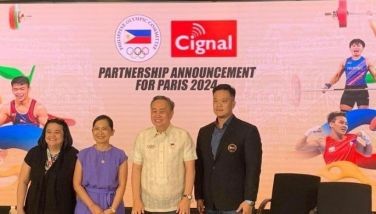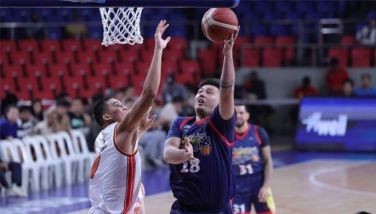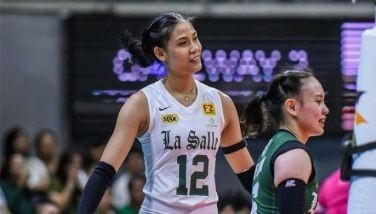Pinoys go full circle in Spain
MANILA, Philippines - It should’ve happened 28 years ago at the FIBA World Cup in Spain. The Philippines earned a ticket to the global competition by virtue of capturing the FIBA Asia (then known as the Asian Basketball Confederation) in Kuala Lumpur in January 1986. But the EDSA Revolution overturned national priorities and the Philippines’ participation at the FIBA World Cup was withdrawn.
In 1986, FIBA allowed countries to recruit a maximum of two naturalized players with the Philippines enjoying the services of Jeff Moore and Dennis Still. The locals in coach Ron Jacobs’ lineup that year were Allan Caidic, Samboy Lim, Hector Calma, Franz Pumaren, Elmer Reyes, Tonichi Yturri, Alfie Almario, Jerry Codiñera, Pido Jarencio, Yves Dignadice and Benjie Gutierrez.
Tonight, the Philippines returns to the country where the national team should’ve played in 1986. Gilas will mark its comeback to the FIBA World Cup after a 36-year wait or since Manila hosted the quadrennial tournament in 1978. This was the competition where the Philippines finished third in Rio de Janeiro in 1954, the highest finish ever by an Asian country. In all, the Philippines has played in four FIBA World Cups, posting an overall record of 12 wins and 18 losses in 1954, 1959, 1974 and 1978.
How appropriate that the Philippines will see action at the FIBA World Cup in Spain because of the close and long relationship between the two countries. It is a fact that when basketball was new to Spain in the pre-war era, a Filipino named Juan Castellvi played the game with Real Madrid. Castellvi was known as the “Soul of the Philippines” and led Real Madrid to its first national championship in 1933. Writer Luis Miguel Gonzalez Lopez, in the book “El Rey De Europa: Historia Del Real Madrid De Baloncesto,” described Castellvi as a highly technical player, agile and skilful with the basketball. Before Castellvi returned to the Philippines, he was awarded the medal of merit in sports by Real Madrid as a tribute to his contributions to the club.
Castellvi wasn’t the only prominent Filipino basketball pioneer in Spain. Two others were Eduardo Hernandez-Villamil and Edmundo Felipe Calderon Kaimo. Villamil was called the “cool and calculating Filipino” by Lopez. At least 40 Filipinos came to Spain to play basketball, noted Lopez, but Villamil was different from the rest. “While most Filipinos played fast, aggressive and emotional basketball, Villamil was known to be cool, especially in the heated moments of a game,” said Lopez. “He arrived in Spain in 1943 and played for coach Anselmo Lopez with Real Madrid. It was Lopez who had a great influence in Villamil’s career. Villamil won two Spanish titles with Real Madrid, the first in his rookie season and the second in his last.”
Villamil played on the Spanish national team and after retiring, became an international referee. He was later appointed vice president of the Spanish Basketball Federation serving under the president who happened to be Lopez, his Real Madrid coach.
Kaimo was dubbed the “Filipino Cyclone.” Lopez said Kaimo represented the spirit of the Filipino player who invaded the Spanish leagues in the 1940s. Kaimo was revered for his quickness, technical skills, defense, passing ability and fighting spirit. He went to Spain in 1947 and joined Villamil at Real Madrid. Kaimo electrified the fans with his dizzying passes and was described by Lopez as sensational. He played on two Spanish national title squads in two seasons.
When Real Madrid coach Jose Borrero left, Kaimo and teammate Freddy Borras were named playing coaches. Kaimo and Borras conspired to deliver a Spanish championship to Real Madrid in 1948.
Because the Philippines was more advanced than Spain in basketball, Filipino teams were often invited to play exhibitions in Madrid and Barcelona. In 1955, a year after the Philippines took the bronze medal at the FIBA World Cup, the YCO squad coached by Leo Prieto went on a basketball tour of Spain. Prieto’s lineup included Caloy Loyzaga, Tony Genato, Ramoncito Campos, Paeng Hechanova, Pocholo Martinez, Tito Eduque, Pablo Cuna and Eddie Lim. Writer Fernando Font, in the book “El Libro De Oro Del Basket,” said the Spanish fans were enthralled by YCO’s technique, skills and innovative play. “One phenomenal small player Genato jumped like a cat and suspended himself in mid-air, shot on the run and amazed the fans in packed stadiums,” said Font. But the brightest Filipino star was Loyzaga whom Font described as famous for his exploits in 1954. That year, Loyzaga was the FIBA World Cup’s second leading scorer with 148 points in nine games and shot 31 points in the Philippines’ 67-63 win over Uruguay.
The Philippines opens its campaign against Croatia at the FIBA World Cup in Seville tonight. Venue is the 7,127-seat Palacio Municipal de Deportes. The Philippines will play Greece tomorrow, Argentina on Monday, Puerto Rico on Wednesday and Senegal on Thursday. If the Philippines finishes in the top four of the six-team Group B, it will advance to the knockout Round-of-16 on Sept. 6, Saturday, in Madrid.
- Latest
- Trending

























